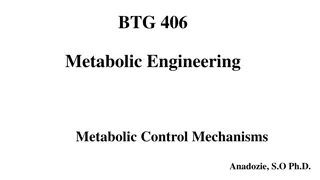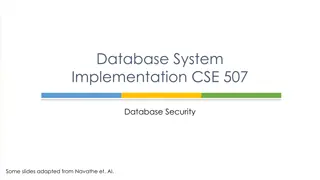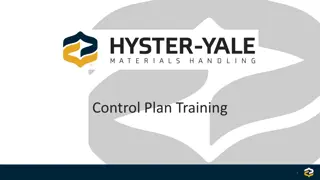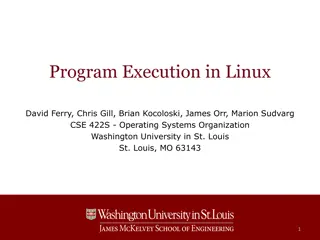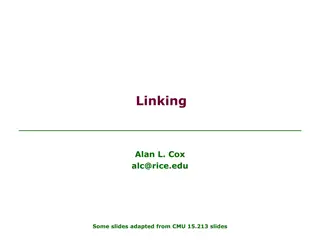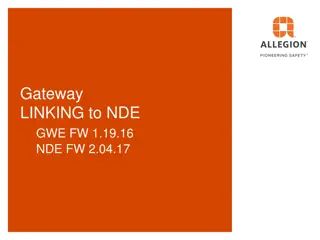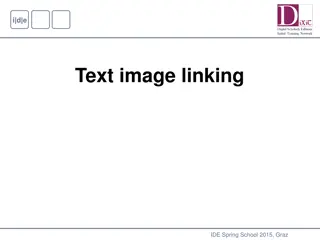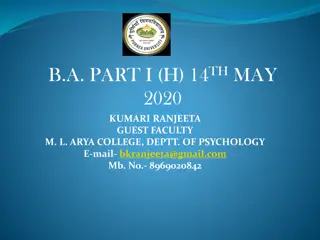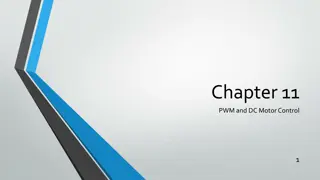Linking Mechanisms for Program Control
In systems programming, controlling hardware, operating systems, and software is key. Dive into the intricacies of linking mechanisms to uncover programmable features that offer unexpected levels of control over program behavior. Learn about dynamic linking, method interpositioning, and the difference between static and dynamic linking in Linux. Explore how linking enables sophisticated wrappers and the manipulation of APIs within existing systems.
Uploaded on Mar 17, 2025 | 3 Views
Download Presentation

Please find below an Image/Link to download the presentation.
The content on the website is provided AS IS for your information and personal use only. It may not be sold, licensed, or shared on other websites without obtaining consent from the author.If you encounter any issues during the download, it is possible that the publisher has removed the file from their server.
You are allowed to download the files provided on this website for personal or commercial use, subject to the condition that they are used lawfully. All files are the property of their respective owners.
The content on the website is provided AS IS for your information and personal use only. It may not be sold, licensed, or shared on other websites without obtaining consent from the author.
E N D
Presentation Transcript
LINKING HOW BASIC MECHANISMS ENABLE SOPHISTICATED WRAPPERS Professor Ken Birman CS4414 Lecture 13 CORNELL CS4414 - SPRING 2023 1
SYSTEMS PROGRAMMING IS ABOUT TAKING CONTROL OVER EVERYTHING We have seen that a systems programmer learns to program the hardware, operating system and software, including the C++ compiler itself, which we program via templates. Today we will look at how linking works, and by doing so, we will discover another obscure example of a programmable feature that you might not normally expect to be able to control! CORNELL CS4414 - SPRING 2023 2
CORE SCENARIO PART I Libraries can be quite big some are huge. The memory of your computer can easily be completely filled by copies of libraries maybe identical ones! CORNELL CS4414 - SPRING 2023 3
CORE SCENARIO PART II We are given a system that has pre-implemented programs in it (compiled code plus libraries). But now we want to change the behavior of some existing API. Can it be done? CORNELL CS4414 - SPRING 2023 4
IDEA MAP FOR TODAY Libraries Dynamic linking: -shared -fPIC compilation. DLL segments, issue of base address Compiling to an object file Wrappers for method interpositioning: a super hacker technique! Static versus dynamic linking in Linux. Insane/weird part, introduces some amazing features Main part of lecture. Be sure to understand this. CORNELL CS4414 - SPRING 2023 5
Your code Std:xxx libraries LINKING + = Executable Statically linked object files Libraries your company created Compile time Runtime A linker takes a collection of object files and combines them into an object file. But this object file will still depend on libraries. Next it cross-references this single object file against libraries, resolving any references to methods or constants in those libraries. If everything needed has been found, it outputs an executable image. CORNELL CS4414 - SPRING 2023 6
EXAMPLE C PROGRAM (C++ IS THE SAME) int sum(int *a, int n); int sum(int *a, int n) { int i, s = 0; int array[2] = {1, 2}; int main(int argc, char** argv) { int val = sum(array, 2); return val; } for (i = 0; i < n; i++) { s += a[i]; } return s; } sum.c main.c CORNELL CS4414 - SPRING 2023 7
LINKING Gcc is really a compiler driver : It launches a series of sub-programs linux> gcc -Og -o prog main.c sum.c linux> ./prog main.c sum.c Source files Translators (cpp, cc1, as) Translators (cpp, cc1, as) Separately compiled relocatable object files main.o sum.o Linker (ld) Fully linked executable object file (contains code and data for all functions defined in main.c and sum.c) prog CORNELL CS4414 - SPRING 2023 8
WHY LINKERS? REASON 1: MODULARITY Program can be written as a collection of smaller source files, rather than one monolithic mass. But later we need to combine all of these. Each C++ class normally has its own hpp file (declares the type signatures of the methods and fields) and a separate cpp file (implements the class). For fancy templated classes, C++ itself creates the needed cpp files, one for each distinct type-parameters list. CORNELL CS4414 - SPRING 2023 9
AN OBJECT FILE IS AN INTERMEDIATE FORM An object file contains incomplete machine instructions, with locations that may still need to be filled in: Addresses of methods defined in other object files, or libraries Addresses of data and bss segments, in memory After linking, all the resolved addresses will have been inserted at those previously unresolved locations in the object file. CORNELL CS4414 - SPRING 2023 10
TWO FORMS OF ADDRESSING For today s lecture, we think mostly of absolute addresses in the virtual address space, and base-relative ones where some sort of pointer exists, and the object is at an offset from it. Both are supported very efficiently by Intel and AMD/ARM So the compiler thinks which choice is best ? CORNELL CS4414 - SPRING 2023 11
WHICH DOES IT PICK? For branching inside a single method, it favors absolute addressing if feasible, but can also use PC relative ones. For accessing data in a data segment, it can use base relative addressing. Useful if we have multiple code segments and each has its own data segment. In general, absolute addressing is a tiny bit faster. CORNELL CS4414 - SPRING 2023 12
REASON 2 FOR LINKINGS: LIBRARIES Libraries aggregate common functions or classes. Static linking combines modules of a program, but also used to be the main way of linking to libraries: Executables include copies of any library modules they reference (but just those .o files, not others in the library) Executable is complete and self-sufficient. It should run on any machine with a compatible architecture. CORNELL CS4414 - SPRING 2023 13
REASON 2: LIBRARIES Dynamic linking is more common today Your executable program doesn t need to contain library code At execution, single copy of library code is shared, but the dynamic linker does need to be able to find the library file (a .so file) If a dynamically linked executable is launched on a machine that lacks the DLL, you will get an error message (usually, on startup, but there are some obscure cases where it happens later, when the DLL is needed) CORNELL CS4414 - SPRING 2023 14
HOW LINKING WORKS: SYMBOL RESOLUTION Programs define and reference symbols (global variables and functions): void swap() { } /* define symbol swap */ swap(); /* reference symbol swap */ int *xp = &x; /* define symbol xp, reference x */ Symbol definitions are stored in object file in the symbol table. Symbol table is an array of entries Each table entry includes name, type, size, and location of symbol. With C++ the location is the namespace that declared the class CORNELL CS4414 - SPRING 2023 15
THREE CASES A symbol can be defined by the object file. It can be undefined, in which case the linker is required to find the definition and link the object file to the definition. It can be multiply defined. This is normally an error but we will see one tricky way that it can be done, and even be useful! CORNELL CS4414 - SPRING 2023 16
SYMBOLS IN EXAMPLE C PROGRAM Definitions int sum(int *a, int n); int sum(int *a, int n) { int i, s = 0; int array[2] = {1, 2}; int main(int argc, char** argv) { int val = sum(array, 2); return val; } for (i = 0; i < n; i++) { s += a[i]; } return s; } sum.c main.c Reference CORNELL CS4414 - SPRING 2023 17
LINKERS CAN MOVE THINGS AROUND. WE CALL THIS RELOCATION A linker merges code and data sections into single sections As part of this it relocates symbols from their relative locations in the .o files to their final absolute memory locations in the executable. It updates references to these symbols to reflect their new positions. CORNELL CS4414 - SPRING 2023 18
OBJECT FILE FORMAT (ELF) 0 ELF header Segment header table (required for executables) Elf header Word size, byte ordering, file type (.o, exec, .so), machine type, etc. Segment header table Page size, virtual address memory segments + sizes. .text section (code) .rodata section (read-only data, jump offsets, strings) .data section (initialized global variables) .bss section (name bss is lost in history) Global variables that weren t initialized: zeros. Has section header but occupies no space .text section .rodata section .data section .bss section .symtab section .rel.txt section .rel.data section .debug section Section header table CORNELL CS4414 - SPRING 2023 19
EXAMPLE OF SYMBOL RESOLUTION Referencing a global that s defined here int sum(int *a, int n); int sum(int *a, int n) { int i, s = 0; int array[2] = {1, 2}; int main(int argc,char **argv) { int val = sum(array, 2); return val; } for (i = 0; i < n; i++) { s += a[i]; } return s; } sum.c main.c Defining a global Linker knows nothing of i or s Referencing a global Linker knows nothing of val that s defined here CORNELL CS4414 - SPRING 2023 20
SYMBOL IDENTIFICATION Which of the following names will be in the symbol table of symbols.o? Names: incr foo a argc argv b main printf Others? "%d\n" incr foo a argc argv b main printf symbols.c: int incr = 1; static int foo(int a) { int b = a + incr; return b; } int main(int argc, char* argv[]) { printf("%d\n", foo(5)); return 0; } Can find this with readelf: linux> readelf s symbols.o CORNELL CS4414 - SPRING 2023
LOCAL SYMBOLS Local non-static C variables vs. local static C variables Local non-static C variables: stored on the stack Local static C variables: stored in either .bss or .data static int x = 15; int f() { static int x = 17; return x++; } Compiler allocates space in .data for each definition of x int g() { static int x = 19; return x += 14; } Creates local symbols in the symbol table with unique names, e.g., x, x.1721 and x.1724. int h() { return x += 27; } static-local.c CORNELL CS4414 - SPRING 2023 22
HOW LINKER RESOLVES DUPLICATE SYMBOL DEFINITIONS Program symbols are either strong or weak Strong: methods (code blocks) and initialized globals Weak: uninitialized globals (or with specifier extern) p1.c p2.c int foo=5; int foo; weak strong p1() { } p2() { } strong strong but be aware that the weak case can cause real trouble! CORNELL CS4414 - SPRING 2023 23
LINKER WITH MULTIPLE WEAK DECLARATIONS int x; p1() {} Link time error: two strong symbols (p1) p1() {} int x; p1() {} int x; p2() {} References to x will refer to the same uninitialized int. Is this what you really want? int x; int y; p1() {} double x; p2() {} Writes to x in p2 might overwrite y! Evil! int x=7; int y=5; p1() {} double x; p2() {} Writes to x in p2 might overwrite y! Nasty! References to x will refer to the same initialized variable. int x=7; p1() {} int x; p2() {} Important: Linker does not do type checking. But C++ namespaces create a private naming scope. CORNELL CS4414 - SPRING 2023 24
GLOBAL TYPE MISMATCHES CAUSE BUGS long int x; /* Weak symbol */ /* Global strong symbol */ /* Global strong symbol */ double x = 3.14; double x = 3.14; int main(int argc, char *argv[]) { printf("%ld\n", x); return 0; } mismatch-variable.c mismatch-main.c Compiles without any errors or warnings, yet this is a bug! What gets printed? CORNELL CS4414 - SPRING 2023 25
STATIC LIBRARIES atoi.c printf.c random.c ... Translator Translator Translator atoi.o printf.o random.o unix> ar rs libc.a \ atoi.o printf.o random.o Archiver (ar) libc.a C standard library, static version Archiver creates a single file that contains all the .o files, plus a lookup table (basically, a directory ) that the linker can use to find the files. CORNELL CS4414 - SPRING 2023 26
COMMONLY USED LIBRARIES libc.a (the C standard library) 4.6 MB archive of 1496 object files. I/O, memory allocation, signal handling, string handling, data and time, random numbers, integer math libm.a (the C math library) 2 MB archive of 444 object files. floating point math (sin, cos, tan, log, exp, sqrt, ) % ar t /usr/lib/libc.a | sort fork.o fprintf.o fpu_control.o fputc.o freopen.o fscanf.o fseek.o fstab.o % ar t /usr/lib/libm.a | sort e_acos.o e_acosf.o e_acosh.o e_acoshf.o e_acoshl.o e_acosl.o e_asin.o e_asinf.o e_asinl.o CORNELL CS4414 - SPRING 2023 27
LINKING WITH STATIC LIBRARIES libvector.a void addvec(int *x, int *y, int *z, int n) { int i; #include <stdio.h> #include "vector.h" int x[2] = {1, 2}; int y[2] = {3, 4}; int z[2]; for (i = 0; i < n; i++) z[i] = x[i] + y[i]; } addvec.c int main(int argc, char** argv) { addvec(x, y, z, 2); printf("z = [%d %d]\n , z[0], z[1]); return 0; } void multvec(int *x, int *y, int *z, int n) { int i; for (i = 0; i < n; i++) z[i] = x[i] * y[i]; main2.c } multvec.c CORNELL CS4414 - SPRING 2023 28
LINKING WITH STATIC LIBRARIES multvec.o addvec.o main2.c vector.h Archiver (ar) Translators (cpp, cc1, as) Static libraries libvector.a libc.a printf.o and any other modules called by printf.o Relocatable object files main2.o addvec.o Linker (ld) unix> gcc static o prog2c \ main2.o -L. -lvector Fully linked executable object file (861,232 bytes) prog2c c for compile-time CORNELL CS4414 - SPRING 2023 29
USING STATIC LIBRARIES Linker s algorithm for resolving external references: Scan .o files and .a files in the command line order. During the scan, keep a list of the current unresolved references. As each new .o or .a file, obj, is encountered, try to resolve each unresolved reference in the list against the symbols defined in obj. If any entries in the unresolved list at end of scan, then error. Problem: Command line order matters! Moral: put libraries at the end of the command line. unix> gcc -static -o prog2c -L. -lvector main2.o main2.o: In function `main': main2.c:(.text+0x19): undefined reference to `addvec' collect2: error: ld returned 1 exit status CORNELL CS4414 - SPRING 2023 30
SHARED LIBRARIES Static libraries have the following disadvantages: Duplication in the stored executables (every function needs libc) Duplication in the running executables Minor bug fixes in system libraries? Must rebuild everything! Example: hugely disruptive 2016 library issue: https://security.googleblog.com/2016/02/cve-2015-7547-glibc- getaddrinfo-stack.html CORNELL CS4414 - SPRING 2023 31
SHARED LIBRARIES Shared libraries save space and resolve this issue. Term refers to: Object files that contain code and data. Saved in a special directly (LOADPATH points to it). Loaded and linked into an application dynamically, at either load-time or run-time Also called: dynamic link libraries, DLLs, .so files CORNELL CS4414 - SPRING 2023 32
DYNAMIC LIBRARY EXAMPLE addvec.c multvec.c unix> gcc Og c addvec.c multvec.c -fpic Translator Translator addvec.o multvec.o unix> gcc -shared -o libvector.so \ addvec.o multvec.o Loader (ld) Dynamic vector library libvector.so CORNELL CS4414 - SPRING 2023 33
DYNAMIC LINKING AT LOAD-TIME main2.c vector.h unix> gcc -shared -o libvector.so \ addvec.c multvec.c -fpic Translators (cpp, cc1, as) libc.so libvector.so Relocatable object file main2.o Relocation and symbol table info Linker (ld) unix> gcc o prog2l \ main2.o ./libvector.so Partially linked executable object file (8488 bytes) prog2l Loader (execve) libc.so libvector.so Code and data Fully linked executable in memory Dynamic linker (ld-linux.so) CORNELL CS4414 - SPRING 2023 34
FOR DYNAMIC LINKING, RELOCATION OCCURS AT RUNTIME The program using the DLL is coded to access DLL methods via a special indirection table. Initially this table has on entry per library method but all of them are wired to call load on first access This method automatically loads the DLL and patches references CORNELL CS4414 - SPRING 2023 35
REMINDER: MMAPPED FILE A file but fully loaded into memory by the kernel Those physical pages can now show up as virtual pages in any address space that calls mmap() and has permission The pages are only in memory once . The page table entries are small so the overheads are minor. CORNELL CS4414 - SPRING 2023 36
STEPS IN DLL LOADING Automatic, but what the method does is Map the DLL file itself into memory. If it is already in memory the single copy will be shared. This is our space savings That new DLL will need its own private copy of the data and bss segment. Allocate space, and remember the base address. Now, when foo(x) gets called, we just load that base address in a designated register and call (*address_of_foo)(x) ! CORNELL CS4414 - SPRING 2023 37
STEPS IN DLL LOADING AS GRAPHIC Initially, myprog doesn t have the DLL loaded. Calls to methods like fwrite will actually call __loader via function-pointer indirection DLL name Method name Pointer to method / /libc.so fwrite( ) __loader / ./vector.so push_back( ) __loader myprog CORNELL CS4414 - SPRING 2023 38
STEPS IN DLL LOADING AS GRAPHIC On the first call, __loader is invoked and uses Linux file mapping (mmap) to map the DLL into memory. The pages of this segment will be shared, read- only, with other users. Offset: 0x12020 fwrite( ) { } Base address: 0x103290 libc.so fwrite( ) This lets the loader learn the base address of the new segment DLL name Method name Pointer to method / /libc.so fwrite( ) __loader / ./vector.so push_back( ) __loader myprog CORNELL CS4414 - SPRING 2023 39
STEPS IN DLL LOADING AS GRAPHIC Offset: 0x12020 Next, it makes a clone (a private copy) of the data segment and bss segment used by libc.so. The mapped segment has a read-only copy. fwrite( ) { } Base address: 0x103290 libc.so Private data segment fwrite( ) This is because each process using the DLL needs its own version of the global variables DLL name Method name Pointer to method / /libc.so fwrite( ) __loader / ./vector.so push_back( ) __loader myprog CORNELL CS4414 - SPRING 2023 40
STEPS IN DLL LOADING AS GRAPHIC Private data segment Now the loader can patch up the indirection table. A call to fwrite will go to a little method that (1) puts the base address of libc.so and the associated data segment into a register, then calls the version in the mapped memory region Offset: 0x12020 fwrite( ) { } Base address: 0x103290 fwrite( ) libc.so DLL name Method name Pointer to method / /libc.so fwrite( ) __loader / ./vector.so push_back( ) __loader myprog CORNELL CS4414 - SPRING 2023 41
WHEN FWRITE IS INVOKED Main calls the wrapper function. That wrapper arranges for c++ to put the base address in the base address register (the prior value is pushed to the stack) The call occurs and frwrite runs The prior value of the base address register is popped and restored CORNELL CS4414 - SPRING 2023 42
WHY DID WE SAVE MEMORY? The segment holding libc.so could be huge it is hard to get used to sizes of things, but shared libraries can be very large. Many of them have really big in-memory data structures or helper data of various kinds, like ML models. This can add up to gigabytes. Now those will be shared, in read-only mapped memory CORNELL CS4414 - SPRING 2023 43
HOW DOES THE C++ COMPILER KNOW THAT FWRITE( ) WILL LIVE IN A DLL? it does need to know, because the DLL can land at a different place in each process using it. Every process has its own address space layout. So, gcc needs to use pointer and base-relative addressing But who tells it? You do. The DLL developer must say this CORNELL CS4414 - SPRING 2023 44
GCC OPTIONS USED HERE 1) shared, -fpic: To create position independent code (next slide) 2) o something.so: To output result as a DLL 3) rdynamic: Includes dynamic symbol names for gprof, gdb 4) ldr: dr is the directory to look for the .so file in CORNELL CS4414 - SPRING 2023 45
DYNAMIC LINKING AT RUN-TIME dll.c vector.h unix> gcc -shared -o libvector.so \ addvec.c multvec.c -fpic Translators (cpp, cc1, as) libvector.so libc.so Runtime- relocatable object file dll.o Relocation and symbol table info Linker (ld) unix> gcc -rdynamic o prog2r \ dll.o -ldl prog2r libc.so Partially linked executable object file (8784 bytes) Loader (execve) Code and data Dynamic linker (ld-linux.so) Fully linked executable in memory Call to dynamic linker via dlopen CORNELL CS4414 - SPRING 2023 46
RUNTIME ERRORS At runtime, your program searches for the .so file What if it can t find it? You will get an error message during execution, and the executable will terminate. Depending on the version of Linux, this occurs when you launch the program, or when it tries to access something in the dll Some dll files also have versioning data. On these, your program might crash because of an incompatible dll version number CORNELL CS4414 - SPRING 2023 47
LINKING SUMMARY Linking is a technique that allows programs to be constructed from multiple object files Linking can happen at different times in a program s lifetime: Compile time (when a program is compiled) Load time (when a program is loaded into memory) Run time (while a program is executing) Understanding linking can help you avoid nasty errors and make you a better programmer CORNELL CS4414 - SPRING 2023 48
GETTING VERY FANCY: LIBRARY INTERPOSITIONING (FOR SERIOUS HACKERS!) Documented in Section 7.13 of book Library interpositioning: powerful linking technique that allows programmers to intercept calls to arbitrary functions Interpositioning can occur at: Compile time: When the source code is compiled Link time: When the relocatable object files are statically linked to form an executable object file Load/run time: When an executable object file is loaded into memory, dynamically linked, and then executed. CORNELL CS4414 - SPRING 2023 49
1-2-3 RECIPE FOR INTERPOSITIONING Given an executable that obtains something from a library. Create a .o file that defines something, using the same API the executable expected. Relink the executable against your .o file. Now your implementation of something will be called CORNELL CS4414 - SPRING 2023 50
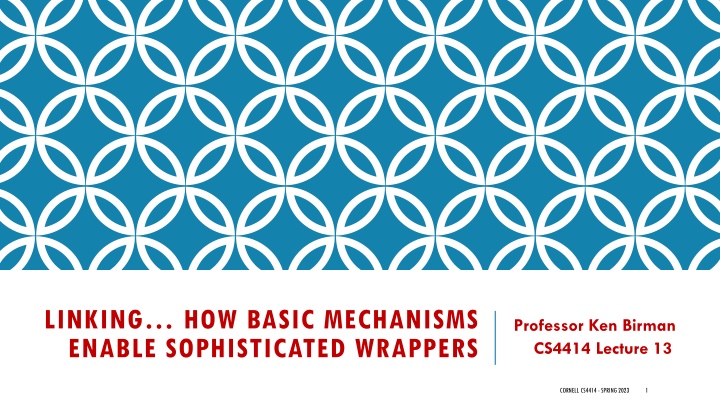

![Read⚡ebook✔[PDF] Linking the Space Shuttle and Space Stations: Early Docking Te](/thumb/21519/read-ebook-pdf-linking-the-space-shuttle-and-space-stations-early-docking-te.jpg)





